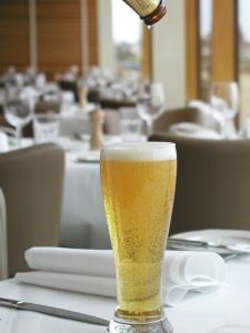A Delicious Dinner Pairing Beer With Each Course
Page 1: How To Begin Your Beer & Food Pairings
CAPSULE REPORT: For centuries, beer and food have been enjoyed together, both as part of the good life and for health reasons—it was often safer to drink beer than water. The grain-based nature of beer makes it a nutritious food in of itself, and the huge range of flavors, aromas and textures makes beer a perfect match for nearly any kind of food, be it a frankfurter or the most luxurious gourmet dish. Choosing beers and foods that enhance one another means paying attention to the gustatory qualities of both. Here, we present six recipes, with suggested beer pairings, from chef and author Lucy Saunders’ book, The Best of American Beer & Food.
This is Page 1 of a seven-page article. To visit the other pages, click on the black links below.
The History Of Beer
Beer has been brewed prior to written history. But ironically, the oldest known recipe set down by man appears to be one for brewing beer, found on stone tablets in Sumer, in southern Mesopotamia—the “fertile crescent” or “cradle of civilization” between the Tigris and Euphrates Rivers that includes modern Iraq, northeastern Syria, southeastern Turkey and southwestern Iran.
Beer is the most frequently-consumed beverage in the world, after water and tea. Some scholars believe that it has been brewed since the sixth millennium B.C.E. By 4000 B.C.E., the Babylonians were brewing at least 16 varieties of beer. The Pharaohs of Egypt paid their workers with jugs of beer (later, the Romans would pay their legions in salt, leaving us with the phrase, “worth his salt,” rather than “worth his beer”). To learn more about beer, check out THE NIBBLE’s glossary of beer terms.
Pairing Beer & Food
The Brewer’s Association, a non-profit organization thatpromotes American craft beer and American craft brewers, provides the following suggestions:
- Match strength with strength. Delicate dishes work best with delicate beers, and strongly flavored foods demand assertive beers. Intensity of flavor may involve many aspects: alcoholic strength, malt character, hop bitterness, sweetness, richness, roastiness and so on.
- Find harmonies. Combinations often work best when they share some common flavor or
 aroma elements. The nutty flavor of an English-style brown ale and a handmade cheddar cheese; the deep, roasted flavors of an imperial stout and chocolate truffles; and the rich, caramelly flavors of an Oktoberfest lager and roasted pork are all examples of this. aroma elements. The nutty flavor of an English-style brown ale and a handmade cheddar cheese; the deep, roasted flavors of an imperial stout and chocolate truffles; and the rich, caramelly flavors of an Oktoberfest lager and roasted pork are all examples of this.
- Consider sweetness, bitterness, carbonation, heat (spice) and richness. Specific characteristics of food and beer interact with each other in predictable ways. Taking advantage of these interactions ensures that the food and beer will balance each other, each giving you a desire for a taste of the other.
Beer photo by Liz Grist | SXC.
Serving Tips
When serving beer, especially to a group, here are some tips you can follow to promote the best flavor and experience for your guests:
- Buy beer fresh. Beer is brewed, not fermented, so bottle age does it no good. Fresher is better. Older beers lose their flavor and go flat. Buying locally produced beers will ensure you purchase a product that has traveled the least amount of distance.
- Buy large bottles. Many craft brewers offer beers in 22 ounce or 750 milliliter bottles that offer a shape and size perfect for sharing at the dinner table.
- Use a carafe. If the beers you want aren’t available in larger bottles, you’ll still want to present the beer in a way that encourages sharing. A perfect way to do this is to pour smaller bottles into a carafe or clear plastic pitcher that can be passed around the table. Just don’t put out too much beer at one time: One to one-and-a-half beers per person should be enough beer on the table at the beginning of the meal.
- Options are nice. Just as some people like dark meat and some like white meat, you’ll find that some guests may prefer one style of beer to another. Offering at least two different choices can help to keep everyone happy.
- Don’t forget glassware. Just like wine, certain glass shapes affect the aroma and flavor of beer, too. The most basic rule is that glass serving size usually correlates with beer strength (inverse relationship). Conical-shaped Pilsner glasses help wedge in or support the head. Curved glasses at the top (like a wine glass) help concentrate aromas. See our article on specific glassware suggestions, or the beer and glass pairing chart on Beertown.org.
Go To Page 2: Spicy Steamed Mussels Recipe
Go To The Article Index Above
|